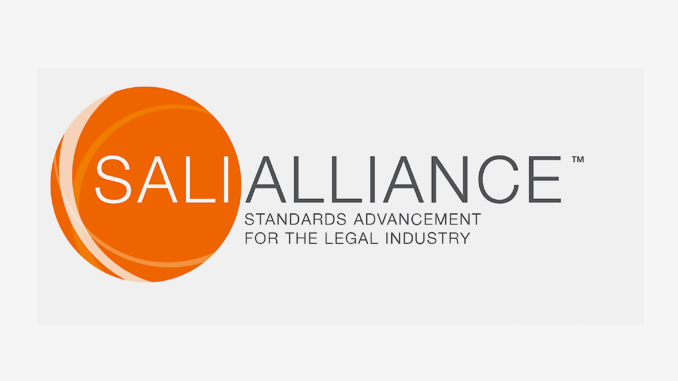
The standardisation movement has taken another positive step as SALI (the Standards Advancement for the Legal Industry Alliance) has released a greatly expanded 2.0 version of its landmark Legal Matter Specification Standard (LMSS).
The group, which started in the US, but now has international support, said that ‘the taxonomy has expanded to almost 10,000 categories, (essentially tags), that the legal market uses to describe its services in detail, and in a way that is comparable across organisations [i.e. to describe legal matters]’.
They added that: ‘Those tags can also fuel legal pricing, AI, and data-science initiatives.’ So, this is a welcome development.
And as they say, you cannot improve what you don’t measure. But, you also cannot measure, or truly organise data in a meaningful way, if you don’t have standards in place to begin with.
In a related move, Ed Walters, CEO and co-founder of legal research company Fastcase, has announced that they have integrated SALI’s latest taxonomy into one of their products.
He told Artificial Lawyer: ‘We are now using NLP parsers developed by Judicata and the new SALI LMS 2.0 standards to tag motion types in Docket Alarm.
‘It creates all kinds of interesting possibilities – you can see historically how individual judges rule on certain kinds of motions, for example. We’re using it to build visual timelines of the events on a docket sheet. Plus, SALI standards also correct the problematic ‘Nature of Suit’ (NOS) codes from PACER.
‘But perhaps most interesting, we’re exposing all of the data in APIs, so law firms can build on top of the data, using standards from SALI. With legal standards used as pleadings tags for public data, exposed through APIs, there’s some really interesting applications to be built to collaborate between law firms and corporate legal departments.’
Going back to the new 2.0 release, Toby Brown, co-founder of The SALI Alliance and Chief Practice Management Officer at Perkins Coie, commented: ‘LMSS 2.0 is, quite simply, innovation in the legal industry at its finest. It is the culmination of countless hours generously volunteered by professionals in law firms, technology companies, service providers, educational institutions, and clients in different roles, pursuing the same vision.
‘A common language for the legal industry is powerful for all of these parties, from legal operations to business development, pricing, knowledge management, and overall law firm business operations. Standardised data is critical to all of these efforts.’
A significant portion of the expanded set of descriptors relate to litigation, including causes of action, document types, phases, and more, enabling robust definition and categorisation of a wide variety of key aspects of disputes, the group added.
Damien Riehl, Fastcase Vice President of Litigation Workflow and Analytics Content, also a former practising lawyer and coder, drove the development of these components of the standard. In addition, Riehl led an effort to migrate the LMSS to a graph database (RDF/OWL) hosted by Stanford University’s WebProtege.
The group also pointed out that many organisations are moving from relational databases (e.g., SQL) to graph databases (e.g., knowledge graphs, Neo4j) as a superior means of describing and managing how information is interrelated.
A graph allows industry players to browse the data and also see how descriptors, data points and concepts relate to one another. But even if organisations are not (yet) using graph systems, their relational-database systems can still get the full benefit of SALI LMSS 2.0 and its richer, more-detailed descriptors and relationships.
Riehl commented: ‘I was delighted to bring my experience as a lawyer and technologist to build out the standard, in substance, function, and presentation,” said Riehl. “The value of the standard is truly unlocked when you see how each attribute works in concert with others in a graph, and Stanford’s interface, WebProtege, demonstrates those relationships simply and elegantly.’
Beyond the move to a graph, key enhancements in LMSS 2.0 include Engagement Terms to define a matter’s business arrangement, Events to identify key milestones in a matter, hundreds of new state court codes, customisation based on Canadian law, and mapping to other widely used industry standards, including UTBMS and PACER nature of suit.
The release of LMSS 2.0 follows increasing momentum and interest in the standard from parties across the legal industry ecosystem, including law firms, service providers, educational institutions, and in-house teams.
Reference implementations reflect the diversity of interest, from early-adopter law firm Goulston & Storrs, to the Attorneys’ Liability Assurance Society (ALAS), to technology company Fastcase’s subsidiaries NextChapter and Docket Alarm.
Membership and endorsements are increasing at a rapid pace for The SALI Alliance, which in 2021 included the Corporate Legal Operations Consortium (CLOC), Bond, Schoeneck & King, Coblentz Patch Duffy & Bass, Courtroom Insights, Fredrikson & Byron, NetDocuments, Ogletree Deakins, OpenText, Sheppard Mullin and Sidley Austin.
Meredith Williams-Range, Chief Knowledge & Client Value Officer, Shearman & Sterling, concluded: ‘At Shearman, we reference SALI’s standards in each firm initiative to align our data with best practices. Where SALI’s taxonomy is well-developed it help us to unify the language we use across Shearman and the legal industry, which improves our data quality and streamlines our work with vendors. We greatly value SALI’s goals to establish legal industry standards and look forward to seeing the developing standards.’
—
If you would like to get involved, or just find out more, then you can contact SALI here: info@sali.org.